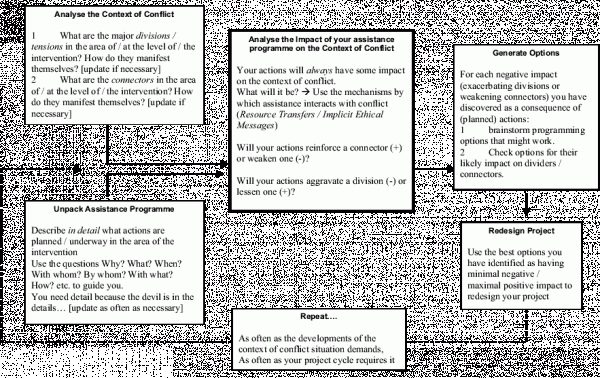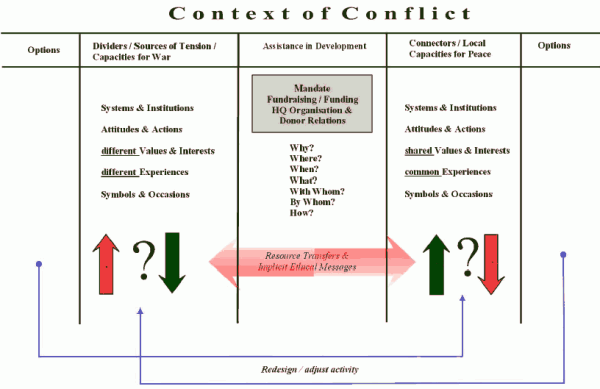|

|
Seven steps to apply the Do No Harm framework:
- Understand the context of conflict.
- Analyse dividers and sources of tension.
- Analyse connectors and LCP.
- Analyse the assistance project.
- Analyse the assistance programme’s impact on the context of conflict through Resource Transfers (RTs) and Implicit Ethical Messages (IEMs).
- Generate programming options.
- Test options and redesign programme.
A general principle of the DNH framework is that broad participation in an analysis and assessment process by all parties is required. Broad participation will help to build a shared perspective of the problem and of the steps necessary to move forward.
Table 1: Flow diagram for conflict assessment and project planning

copyright Local Capacities for Peace Project (LCPP) 2001, adapted from Stephen Jackson
The first and second step is about identifying the dividers, tensions and war capacities in the specific context of conflict and assessing their importance. DC workers must first understand what divides people, the tensions between them, and the capacities for war, i.e. who gains from it. Not all tensions have the same potential for damage: some are local and matter only to a few people and others involve virtually everyone.
|
|

|
Step 1: Understanding the context of conflict:
- Identify the appropriate “arena” – the spatial and social environment, which is relevant to your assistance program;
- Identify which inter-group conflicts have resulted in violence or are dangerous and may escalate into violence;
- Analyse how the aid project relates to that context of conflict
Step 2: Analyse (Identify and unpack) dividers and sources of tension:
- Distinguish between root and proximate causes for conflict;
- Differentiate between sources of tensions or divisions, which affect small numbers of people, and those, which affect many, and between internal and external forces;
- Assess the importance of dividers, tensions and capacities for war.
The third step involves identifying the connectors and local capacities for peace in the same context, and assessing their importance. Often connectors and capacities for peace are not as readily apparent as dividers and capacities for war. One has to see where people maintain contact across fighting lines, and what is it that they share or define as their
common ground.
In assessing the importance of connectors, one has to see whether these capacities for peace are historically grown or are more recent connections, whether they are broad- or narrow-based, and how open and inclusive they are for all groups across the divide.
Step 3: Analyse (Identify and unpack) connectors and LCPs:
- What are the lines of conflict, in which connectors and capacities for peace are important?
- Where do people maintain overt contact and connections across fighting lines?
- Where do people stay connected in less obvious ways?
The fourth and fifth step analyses the developmental co-operation agency and its program. This involves identification of the pertinent characteristics of the aid agency, and assessing and reassessing its impact on the connectors and dividers. All aspects that affect and shape its programmatic decisions are listed, notably mandate, funding structures and sources, areas of intervention, target groups, composition of staff, etc.
These steps also involve the relation of the programme characteristics with the findings of the context analysis (Dividers and connectors). The challenge is to anticipate how each programmatic choice will affect the context. For example, will a decision about staffing reinforce any division which was identified? If staffing choices are seen as reinforcing tensions, it is time to consider alternative options. This has to be done for each programmatic option.
Step 4: Analyse (Identify and unpack) the assistance project:
- Analyse the details of the assistance program. Remember: it is never an entire program that goes wrong. It is the details that determine impact.
Table 2: Context of the conflict

Copyright Local Capacities for Peace Project (LCPP) 2001, based on Anderson, Mary B., 1999
|
 |
Step 5: Analyse the assistance programme’s impact on the context of conflict through Resource Transfers (RTs) and Implicit Ethical Messages (IEMs):
- What is the impact of the programme’s RTs and IEMs on dividers and sources of tension?
- What is the impact of the programme’s RTs and IEMs on connectors and local capacities for peace?
Depending on the results of the Do No Harm analysis, the last two steps deal with potential negative impacts of the programme. Alternative options, which assist in re-designing the programme, will be developed and tested.
Step 6: Generate programming options:
- If an element of the assistance programme has a negative impact on dividers (Strengthening/reinforcing dividers, feeding into sources of tension), or a negative impact on connectors (Weakening/undermining connectors and LCPs), then generate as many options as possible.
The questions is how to do what you intend to do, in such a way as to weaken dividers and strengthen connectors.
|




